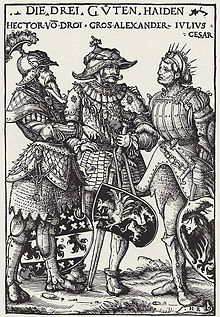Nine Worthies
The Nine Worthies are nine historical, scriptural, and legendary men of distinction who personify the ideals of
The Nine Worthies include three pagans (Hector, Alexander the Great and Julius Caesar), three Jews (Joshua, David and Judas Maccabeus) and three Christians (King Arthur, Charlemagne and Godfrey of Bouillon).
Origin





They were first described in the early fourteenth century, by
The 1459
Classification
The Nine Worthies comprise a triad of triads as follows:
Pagans
Jews
Christians
Cultural references
Literature
The Nine Worthies were also a popular subject for
Don Quixote evokes the Nine Worthies in Volume I, Chapter 5, telling a peasant (who is trying to get him to admit who he is) "I know that I may be not only those I have named, but all the Twelve Peers of France and even all the Nine Worthies, since my achievements surpass all that they have done all together and each of them on his own account".[7]
Art
The Nine Worthies had not devolved to folk culture even in the seventeenth century, for a frieze of the Nine Worthies, contemporary with Shakespeare's comedy, was painted at the outset of the seventeenth century at North Mymms Place, Hertfordshire, an up-to-date house built by the Coningsby family, 1599.[8]
The Cloisters, in New York City, has important portions of an early 15th-century tapestry series illustrating the surviving five of the Nine Worthies: King Arthur, Joshua, David, Hector, and Julius Caesar.[9]
I Nove Prodi, a fresco by the Maestro del Castello della Manta, an
Montacute House has sculptures of the Nine Worthies spaced along the upper eastern façade on the exterior of the long gallery piers. These figures are dressed in Roman armour.
Nine Worthy Women
In the late fourteenth century, Lady Worthies began to accompany the Nine Worthies, though usually not individualized and shown as anonymous Amazon-styled warriors. In later years, nine of the "Most Illustrious Ladies of All Ages and Nations" were chosen from scripture, history and legend to be placed alongside their male counterparts, though the choices for the Lady Worthies were not usually standardized and often varied by region, author and artist.

A very fine set of
In the
The Christian trio of saints, all very popular in Germany at the time, are all women who had been married - Bridget became an abbess as a widow. In addition, like three of the male worthies, Elizabeth of Hungary was an ancestor of Burgkmair's patron Maximilian I, Holy Roman Emperor, and Helena was a Roman Empress. Unlike the other two groups, who all face each other, apparently in conversation, these three all look down, and may illustrate the female virtue of silence.[13] Burgkmair's conception was not very widely followed.
Nine Worthies of London
Nine Worthies of London is a book by Richard Johnson, written in 1592, which borrows the theme from the Nine Worthies. The book is subtitled Explaining the Honourable Excise of Armes, the Vertues of the Valiant, and the Memorable Attempts of Magnanimous Minds; Pleasaunt for Gentlemen, not unseemly for Magistrates, and most profitable for Prentises, celebrated the rise of nine famous Londoners through society from the ranks of apprentices or commoners.
The nine were Sir
, Sir John Bonham, Christopher Croker, Sir Henry Maleverer of Cornhill, and Sir Hugh Calverley.The term "Nine Worthies" was later used to refer to nine of the privy councillors of William III: Devonshire, Dorset, Monmouth, Edward Russell, Carmarthen, Pembroke, Nottingham, Marlborough, and Lowther.
See also
References
- ^ Larousse Dictionnaire de la Langue Francaise Lexis, 1993: Brave, Vaillant
- ^ Johan Huizinga, The Waning of the Middle Ages, (1919) 1924:61.
- ^ a b c d Huizinga 1924:61.
- Tenth Muse".
- ^ "Love's Labor's Lost - Entire Play | Folger Shakespeare Library". www.folger.edu. Retrieved 2023-06-16.
- ^ Shakespeare, William, Henry IV, Part 2, Act 2, Scene 4.
- ^ Chapter V – In which the narrative of our knight's mishap is continued
- ^ "North Mymms Park – A short history. Chapter 3 – Wall Paintings". Archived from the original on 2011-05-14. Retrieved 2005-09-13.
- ^ "King Arthur: Tapestry Fragment from the Series, Five Worthies and Attendant Figures (with 32.130.3a, b) | All | The Cloisters | Collection Database | Works of Art | The Metrop..."
- ^ le chevalier errant, Bibliothèque nationale, Paris, mss. Fr. 12559, fol. 125v; manuscript dated to 1403-04
- ^ Artemesia in Milan Archived 2016-01-26 at the Wayback Machine, David in NGA Washington Archived 2008-09-25 at the Wayback Machine, Alexander in Birmingham
- ISBN 1-558-61039-1
- ISBN 1-55861-039-1
External links
 Media related to Nine Worthies at Wikimedia Commons
Media related to Nine Worthies at Wikimedia Commons- "The Nine Worthies" presented by Heraldica.org.
